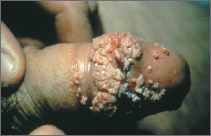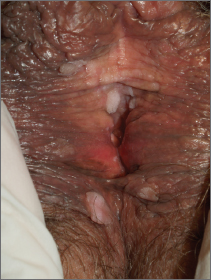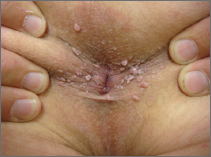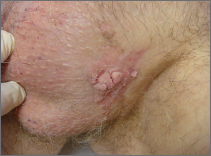Genital warts, also known as venereal warts or condyloma acuminatum, are a very common sexually transmitted disease.
These usually smooth or cauliflowerlike growths are seen in the vicinity of the penis, vagina, vulva, cervix, and anus.
Genital warts
Genital warts are caused by a virus, the human papilloma virus (HPV). The type of HPV that causes genital warts is probably not the same subtype that causes the common wart.
It is thought that most genital warts are spread by sexual contact; however, recent evidence suggests that nongenital spread of the virus can also occur.
These warts have a fairly long incubation period and may appear several weeks or even years after sexual contact; thus, it is difficult to determine the origin of the infection in people who have had multiple sexual partners. Therefore, many infected persons are carriers of the virus and may never develop warts but still can transmit them to their sexual partners.
Mothers who have genital HPV can infrequently transmit genital warts to their infants during delivery.
Genital warts
The diagnosis of genital warts is often simple; however, when they are very small and difficult to see, they may be confused with normal structures of the skin.
Sometimes a skin biopsy is performed to confirm the diagnosis.
In women, evidence of the viral infection may be detected during a routine pelvic examination or a Pap smear.
Treatment is often difficult because no specific agent—antibiotic, antiviral, or otherwise—is available to actually destroy the virus.
The biggest problem is the tendency for the warts to recur, whichever method is used. It is impossible to predict who will have recurrences.
Perianal warts
Electrodesiccation uses a direct electric current to destroy the warts after local anesthesia is used.
Interferon alpha is available as an injectable treatment. It is expensive, has more side effects, and may not offer any great advantage over the other treatments.
Genital warts
Imiquimod (Aldara) and podofilox (Condylox) are medications that may be self-applied. Both require a prescription.
Spread of warts can be lessened by the use of condoms; however, a condom may not cover all warts.
Recently, the Food and Drug Administration approved an HPV vaccine known as Gardasil. The vaccine provides protection against four types of HPV-associated cervical cancers and genital warts. It is approved for females from 9 to 26 years of age.
What are the long-term consequences of HPV?
In many patients with HPV, the immune system keeps the virus under control or manages to eliminate it; however, a minority of people develop a persistent infection that doesn't go away.
Over time, women with long-standing HPV are at higher risk of developing changes in the cells of the cervix. That condition can eventually progress to cervical cancer. Therefore, it is recommended that female partners of affected people be seen by a gynecologist.
Outline




